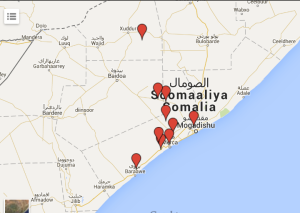ANALYSIS: AMISOM Vacates 10 Towns in Somalia Amid Al-Shabaab’s Ramadan Attacks
On June 26, al-Shabaab executed one of its biggest attacks ever against AMISOM forces as it overran Burundians who had been manning a base in Leego, situated 100km northwest of Mogadishu.
Al-Shabaab claimed to have killed more than 80 Burundians while Burundian army spokesperson Gaspard Baratuza told DPA International that more than 50 troops were killed out of the approximately 100 soldiers at the base. Al-Shabaab publicly released dozens of photos of the attack and the huge weapons cache that it was able to retrieve from the operation.
Long after al-Shabaab made away with the loot, Ethiopian troops were able to take over the base from the Burundians who had fled and did not return.
Most importantly, AMISOM has withdrawn from nine other areas since the raid, including Dayniile, Tooratorow, Yaq Bari Weyne, Buufow, Ababay, Qoryooley, Awdheegle, and Golweyne.
Al-Shabaab filled the gap left by AMISOM and moved into several of these areas, including Leego, Qoryooley, Mubarak, Tooratorow Mubarak, Yaq Bari Weyne, and Bufow.
[UPDATE] AMISOM responded to these reports by saying that it would not leave towns in a way that would allow al-Shabaab to re-gain ground and admitted that its forces were “re-adjusting and re-organizing…to revitalize an already effective strategy.” The press statement attempts to counter reports of its withdrawals but implicitly admits to doing so — all while not addressing the fact that al-Shabaab reportedly moved into these areas.
Ramadan Offensive
Al-Shabaab’s intensification of attacks during Ramadan has been a signature tactic of the group. This year’s string of asymmetric operations exemplifies lessons learned from its failed efforts during the 2010 Ramadan to kick AMISOM out of Mogadishu through direct confrontations, which proved disastrous to the group and divisive among senior leadership.
In the days leading up to this year’s holy month, AMISOM praised its troops performance, promised safety during the Ramadan, and even highlighted newfound freedoms for residents in Tooratorow (ironically before it later withdrew from the town.)
AMISOM is experiencing a backslide at a time in which there are expectations that it should be planning to clear al-Shabaab from the rest of its safehavens with Somali forces by 2016. The Burundian troops, whose own domestic conflict is making some question the sustainability of their troops in Somalia, are not exactly proving their criticality to this mission by its failure to secure the Leego base.
There are several points that explain why AMISOM has reached the current impasse, how it has responded, and what it means for these troops and al-Shabaab moving forward.
1. VOA Somali journalist Harun Maruf and peacekeeping operations expert Professor Paul D. Williams highlighted the resourcing and coordination shortfalls of AMISOM that contributed to the failed response to the Leego attack.
“AMISOM is stretched…22,000 troops is not adequate to control the whole of south-central Somalia. But…the mission lacks the aviation assets that would enable them to destroy more al-Shabab assets. Air power is needed for operations and for reinforcing troops like the Burundian unit…Some commanders are not taking orders directly from A4. In response to the Leego attack, AMISOM has released photos of joint security operations that its troops and Somali forces were carrying out in Mogadishu, possibly to counter perceptions that its troops had let their guard down. This probably will not be enough to convince observers that AMISOM has responded appropriately to the worrying loss of momentum against al-Shabaab during Ramadan. Al-Shabaab probably won’t put up a fight to hold the towns if AMISOM re-advances. But the unpredictability of AMISOM operations continues to complicate the timeline under which it is expected that AMISOM and Somali forces defeat al-Shabaab.
5. The huge cache of weapons and AMISOM uniforms that al-Shabaab seized in the raid likely will boost the group’s morale and operational capabilities at a time in which its financial and material resources may be taking a hit after losing towns in the last few years.

6. Despite the intense operations that al-Shabaab has been able to pull off during Ramadan, the group’s actions largely have been left out of international press, probably because it is not aligned with ISIS, whose affiliates generally garner more attention. Al-Shabaab’s Leego attack went unmentioned in many media outlets on the same day in which “terror spanned three continents“. The group faces some noted obstacles to breaking its alliance with al-Qaida if it so chooses, but the faint notice media has paid to it this week highlights the significantly broader media coverage, and probably enhanced financial support, it would gain if it merged with ISIS
MISOM commanders. Instead they are seeking direction from their countries…There is not even a plan to reinforce each other when attacked [in Leego] like this nature.”
2. AMISOM’s withdrawal from these towns could be a sign of anxiety, with the troop contributing countries possibly relocating forces that were in vulnerable areas to bases with consolidated forces. The withdrawal from a modestly-sized (and ostensibly well-fortified) city like Qoryooley casts some doubt on this theory. However, AMISOM’s exits from these towns is a negative indicator of morale.
3. AMISOM’s failure to protect territorial gains and hasty withdrawal from towns may reinforce perceptions that foreign troops prioritize collecting nice salaries rather than fighting al-Shabaab, especially as Somali forces often go months without pay.
Source:http://somaliamediamonitoring.org/
